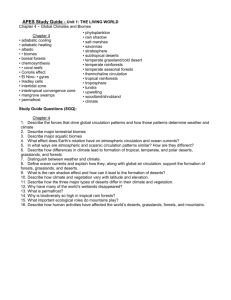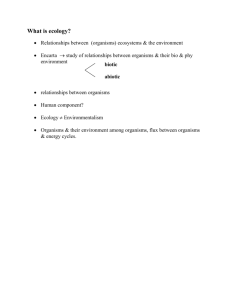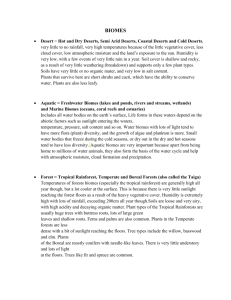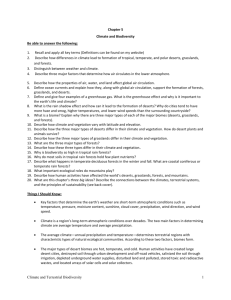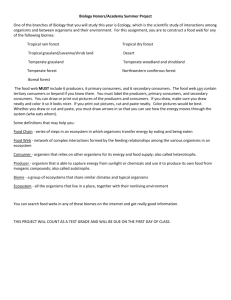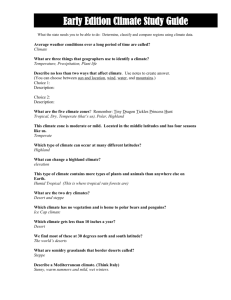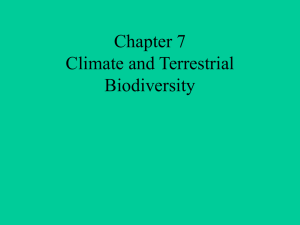Chapter 6: Aquatic Biodiversity
advertisement
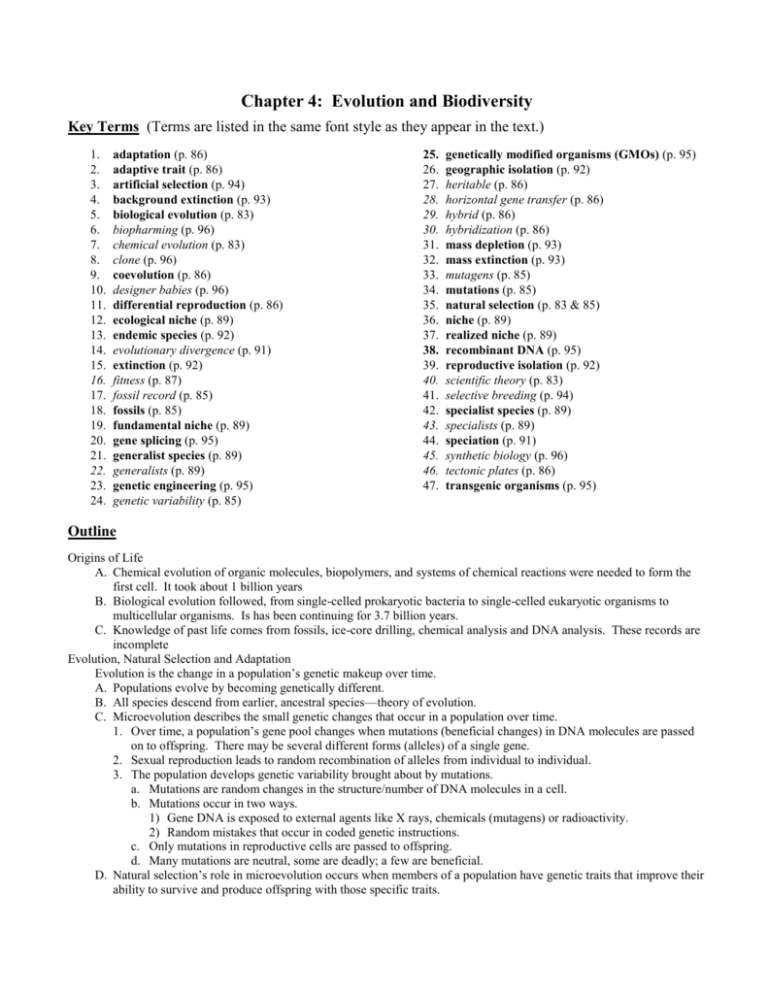
Chapter 4: Evolution and Biodiversity Key Terms (Terms are listed in the same font style as they appear in the text.) 1. 2. 3. 4. 5. 6. 7. 8. 9. 10. 11. 12. 13. 14. 15. 16. 17. 18. 19. 20. 21. 22. 23. 24. adaptation (p. 86) adaptive trait (p. 86) artificial selection (p. 94) background extinction (p. 93) biological evolution (p. 83) biopharming (p. 96) chemical evolution (p. 83) clone (p. 96) coevolution (p. 86) designer babies (p. 96) differential reproduction (p. 86) ecological niche (p. 89) endemic species (p. 92) evolutionary divergence (p. 91) extinction (p. 92) fitness (p. 87) fossil record (p. 85) fossils (p. 85) fundamental niche (p. 89) gene splicing (p. 95) generalist species (p. 89) generalists (p. 89) genetic engineering (p. 95) genetic variability (p. 85) 25. 26. 27. 28. 29. 30. 31. 32. 33. 34. 35. 36. 37. 38. 39. 40. 41. 42. 43. 44. 45. 46. 47. genetically modified organisms (GMOs) (p. 95) geographic isolation (p. 92) heritable (p. 86) horizontal gene transfer (p. 86) hybrid (p. 86) hybridization (p. 86) mass depletion (p. 93) mass extinction (p. 93) mutagens (p. 85) mutations (p. 85) natural selection (p. 83 & 85) niche (p. 89) realized niche (p. 89) recombinant DNA (p. 95) reproductive isolation (p. 92) scientific theory (p. 83) selective breeding (p. 94) specialist species (p. 89) specialists (p. 89) speciation (p. 91) synthetic biology (p. 96) tectonic plates (p. 86) transgenic organisms (p. 95) Outline Origins of Life A. Chemical evolution of organic molecules, biopolymers, and systems of chemical reactions were needed to form the first cell. It took about 1 billion years B. Biological evolution followed, from single-celled prokaryotic bacteria to single-celled eukaryotic organisms to multicellular organisms. Is has been continuing for 3.7 billion years. C. Knowledge of past life comes from fossils, ice-core drilling, chemical analysis and DNA analysis. These records are incomplete Evolution, Natural Selection and Adaptation Evolution is the change in a population’s genetic makeup over time. A. Populations evolve by becoming genetically different. B. All species descend from earlier, ancestral species—theory of evolution. C. Microevolution describes the small genetic changes that occur in a population over time. 1. Over time, a population’s gene pool changes when mutations (beneficial changes) in DNA molecules are passed on to offspring. There may be several different forms (alleles) of a single gene. 2. Sexual reproduction leads to random recombination of alleles from individual to individual. 3. The population develops genetic variability brought about by mutations. a. Mutations are random changes in the structure/number of DNA molecules in a cell. b. Mutations occur in two ways. 1) Gene DNA is exposed to external agents like X rays, chemicals (mutagens) or radioactivity. 2) Random mistakes that occur in coded genetic instructions. c. Only mutations in reproductive cells are passed to offspring. d. Many mutations are neutral, some are deadly; a few are beneficial. D. Natural selection’s role in microevolution occurs when members of a population have genetic traits that improve their ability to survive and produce offspring with those specific traits. 1. For natural selection to evolve in a population, three conditions are necessary: a. The population must have genetic variability. b. The trait must be heritable, capable of being passed from one generation to another. c. The trait must enable individuals with the trait to produce more offspring than individuals without the trait; this is differential reproduction. 2. Adaptation or adaptive traits are heritable traits that help organisms to survive and reproduce better under prevailing environmental conditions. 3. Environmental changes require adaptations also. Organisms must: a. Adapt to the new conditions. b. Migrate to an area with more favorable environment. c. Become extinct. 4. Microevolution follows this process: genes mutate, individuals are selected, and populations evolve. E. Interactions between species can result in microevolution in each of their populations, a process called coevolution. Sometimes the predators have the advantage; sometimes the prey is better adapted. F. Individuals of two species can crossbreed to produce a hybrid and some species can exchange genes without sexual reproduction through horizontal gene transfer. G. Natural selection can only act on existing genes and is limited by reproductive capacity. H. Natural selection does not strive to create the perfect organism; the purpose is to leave the most descendants. Geologic Processes, Climate Change, Catastrophes, and Evolution A. Processes such as the shifting of tectonic plates, volcanic eruptions, and earthquakes influence earth’s climate and in turn affect evolution by removing and/or isolating habitats and species. B. Long-term climate changes relocate ecosystems, thus determining where certain species can live. C. Asteroids and meteorites have caused environmental stress and mass extinctions. Ecological Niches and Adaptations. A. An ecological niche is a species’ way of life in an ecosystem, everything that affects its survival and reproduction. 1. The niche includes the members’ adaptations; its range of tolerance for physical and chemical conditions, its interactions with other components of the ecosystem, and its role in energy flow and matter recycling. 2. The fundamental niche is the full potential range of conditions and resources a species could potentially use. Its realized niche is the part of the potential niche that allows a species to survive and avoid competition with other species for the same resources. B. Some species have broad ecological roles and are termed generalist species. 1. Their living range is broad, includes many different places. 2. They can eat a variety of foods, and tolerate a wide range of environments. 3. If environment is changeable, the generalist will survive better than the specialist. C. Some species have narrow ecological roles and are termed specialist species. 1. Specialist species can live only in very specific environments. 2. This makes them more prone to extinction when environmental conditions change. 3. If the environment is constant, specialists have fewer competitors. 4. Intense competition may lead to evolutionary divergence of a single species into variety of similar species with specialized niches. D. A population’s gene pool and its rate of reproduction limit the population’s ability to adapt to new environmental conditions. 1. The only genetic traits that can adapt are those already in the gene pool. 2. A population’s reproductive capacity limits those genes that can adapt. a. Genetically diverse species that reproduce quickly, can often adapt quickly. b. Populations that reproduce slowly take a long time to adapt through natural selection. c. For a new favorable trait to predominate most of an existing population would have to die prematurely. Speciation, Extinction, and Biodiversity A. Natural selection can lead to development of an entirely new species. In speciation, two species arise from one when some members of a population cannot breed with other members to produce fertile offspring. Speciation occurs in two phases: 1. Geographic isolation, physical separation for long time periods. 2. Reproductive isolation. The gene pools are so changed that members become so different in genetic makeup that they cannot produce fertile offspring. B. When population members cannot adapt to changing environmental conditions, the species becomes extinct. 1. A species manages to survive one to ten million years before extinction occurs. 2. Life has had to cope with many major natural disasters that may reduce or eliminate species. 3. Introduction of new species into an area has also led to reduction in number or elimination of species. C. When local environmental conditions change, some species will disappear at a low rate; this is called background extinction. D. Mass extinction is a significant rise in extinction rates above the background extinction level. Usually, from 25-70% of species are lost. Recent evidence suggests that there have been two mass extinctions on earth. There appear to have been three mass extinctions on earth. E. Adaptive radiations are recovery periods after mass extinction when numerous new species evolve to fill niches in changed environments. It takes one to ten million years to rebuild biological diversity after a mass extinction/depletion. F. The earth’s biodiversity is decreasing because of human activities. 1. Biodiversity equals speciation minus extinction. 2. Humans are causing the premature extinction of species, estimated to be 100 to 1,000 species per million species. 3. It has been predicted that by the end of the 21 st century we may see the extinction of half of the present species now on earth. 4. Humans and their activities are also destroying/degrading ecosystems that might be centers for future speciation. Genetic Engineering and the Future of Evolution A. Man has used artificial selection to change the genetic characteristics of populations. 1. We use selective breeding to obtain specific desired traits. 2. Traditional crossbreeding is a slow process; it takes many generations of selection for the desired trait. 3. Genetic engineering/gene splicing are techniques that isolate, modify, multiply and recombine genes from different organisms. Genes from different species that would never interbreed in nature are being transferred to each other. 4. Genetically modified organisms (GMOs)/transgenic organisms are the results of this gene splicing. a. Gene splicing takes half as much time to develop a new crop/animal, as does traditional crossbreeding. b. Cloning produces a genetically identical version of an individual. c. Biopharming is a new field where genetically engineered animals act as biofactories to produce drugs, vaccines, antibodies, hormones, etc. B. Genetic engineering is an unpredictable process and raises privacy, ethical, legal and environmental issues. It is a trial and error process. 1. The average success rate of genetic engineering experiments is about 1%. 2. There are many questions about gene therapy: who will be helped with genetic knowledge—only those who can pay for it? If one has a defect, will s/he be able to get health insurance, or a job? Should we clone spare parts for people’s bodies? 3. A backlash developed in the 1990’s against increased use of genetically modified food plants and animals. 4. Proponents of more careful control of genetic engineering point out that most new technologies have had unintended, harmful consequences, so that caution should be practiced regarding genetic engineering. C. Humans have become such a powerful species so quickly due to two evolutionary adaptations: complex brain and strong opposable thumbs. 1. Humans have quickly developed powerful technologies to meet our needs and wants. 2. Humans need to change our ways in order not to be called Homo ignoramus instead of Homo sapiens sapiens, the doubly wise. Chapter 5: Climate and Terrestrial Biodiversity Key Terms (Terms appear in the same font as they appear in the text.) 1. 2. 3. 4. 5. 6. 7. alpine tundra (p. 115) arctic tundra (p. 114) average precipitation (p. 101) average temperature (p. 101) biomes (p. 106) boreal forests (p. 120) broadleaf deciduous trees (p. 119) 8. 9. 10. 11. 12. 13. 14. broadleaf evergreen plants (p. 117) browsing (p. 111) canopy (p. 118) chaparral (p. 115) climate (p. 101) coastal coniferous forests (p. 121) cold deserts (p. 108) 15. 16. 17. 18. 19. 20. 21. 22. 23. 24. 25. 26. 27. 28. 29. 30. 31. 32. 33. coniferous evergreen trees (p. 120) convection (p. 103) Coriolis effect (p. 102) desert (p. 108) elevation (p. 101) evergreen coniferous forests (p. 120) forest (p. 117) global warming (p. 104) grasslands (p. 111) grazing (p. 111) greenhouse effect (p. 104) greenhouse gases (p. 104) Gulf Stream (p. 103) islands of biodiversity (p. 122) latitude (p. 101) microclimates (p. 105) monsoons (p. 105) muskegs (p. 121) permafrost (p. 114) 34. 35. 36. 37. 38. 39. 40. 41. 42. 43. 44. 45. 46. 47. 48. 49. 50. 51. polar grasslands (p. 114) prairies (p. 108) prevailing winds (p. 102) savanna (p. 111) short-grass prairies (p. 108) southern pine forests (p. 121) succulent plants (p. 108) taigas (p. 120) tall-grass prairies (p. 108) temperate deciduous forests (p. 119) temperate deserts (p. 108) temperate grasslands (p. 108) temperate rain forests (p. 121) temperate shrubland (p. 115) tropical deserts (p. 108) tropical dry forests (p. 119) tropical rain forests (p. 117) weather (p. 101) Outline Climate: A Brief Introduction A. Weather is a local area’s short-term physical conditions such as temperature and precipitation, typically considered in hours or days, and climate is a region’s average weather conditions over a long time, typically considered over decades. Average temperature and average precipitation are the two major factors that determine climate of a region, together with the related factors of latitude and elevation. B. Global air circulation is affected by the uneven heating of the earth’s surface by solar energy, seasonal changes in temperature and precipitation, rotation of the earth on its axis, and the properties of air, water, and land. 1. Uneven heating of earth’s surface, the equator is heated more than the poles. This is due to the angle of the sun’s rays on different parts of the earth. 2. Seasonal changes in temperature and precipitation due to the tilt of the earth. 3. Rotation of the earth on its axis results in the earth moving faster beneath air masses at the equator and slower at the poles. Belts of prevailing winds are the result. 4. Properties of air, water, and land affect global air circulation. Water evaporation sets up cyclical convection cells. These occur both vertically and from place to place in the troposphere. The result is an irregular distribution of climates and patterns of vegetation from pole to pole. C. Ocean currents influence climate by distributing heat from place to place and mixing and distributing nutrients. 1. Differences in water density and heat create ocean currents that are warm/cold. 2. Currents, such as the Gulf Stream, redistribute absorbed solar heat from one place to another, influence vegetation and climate near coastal regions. 3. Currents also help mix ocean waters to distribute nutrients and dissolved oxygen needed for aquatic organisms. 4. Winds and the earth’s rotation drive the currents. D. Water vapor, carbon dioxide, and other gases influence climate by warming the lower atmosphere and the earth’s surface. 1. These gasses (water vapor, carbon dioxide, methane, and nitrous oxide) are known as greenhouse gasses. They allow mostly visible light, some infrared radiation and ultraviolet radiation to pass through the troposphere. This natural warming is the greenhouse effect. 2. The earth would be a cold, mostly lifeless place without this effect. 3. Human activities have added to the carbon dioxide, methane and nitrous oxide in the atmosphere. The fear is that this can increase the natural greenhouse effect and lead to global warming. 4. Precipitation patterns, sea levels and crop growing areas could be altered. E. Interactions between land and oceans and disruptions of airflows by mountains and cities affect local climates. Various topographic features can create local and regional climates different from the general climate of a region. 1. One example of this is the rainshadow effect, where an air mass moves inland from an ocean, reaches a mountain range, and as the air is forced to rise, it cools and loses moisture on the windward side. The leeward side of the mountain will be drier due to the loss of moisture on the windward side. 2. Bricks, asphalt and other building materials create distinct microclimates in cities that are warmer, have more haze and smog and lower wind speeds than the countryside around them. Biomes: Climate and Life on Land A. Different climates lead to different communities of organisms, especially vegetation. Differences in average temperature and precipitation due to global air and water circulation lead to differences in climate. Scientists divide the world into several major biomes (Figure. 5-9). 1. Average annual precipitation, temperature and soil type are the most important factors in producing tropical, temperate, or polar deserts, grasslands, and forests. 2. Biomes are actually a mosaic of different biological communities, but with similarities unique to the biome (forest, grassland, desert). 3. Climate and vegetation vary with latitude and elevation of an area. Latitude measures distance from the equator, elevation measures elevation above sea level. Desert Biomes A. Deserts have little precipitation and little vegetation and are found in tropical, temperate, and polar regions. Deserts cover about 30% of the earth’s land surface, mostly in tropical and subtropical regions. The largest ones are found in the interior of continents. Others form because of the rain shadow effect on the down side of mountains. 1. Tropical deserts are hot, dry most of the year with few plants, rocks and sand. 2. Temperate deserts have high day temperatures in summer, low temperatures in winter with more rain than in tropical deserts. Plants are widely spaced, mostly drought-resistant shrubs, cacti/succulents. 3. Cold deserts have cold winters, warm summers with low rainfall. B. Desert plants and animals have adaptations that help them stay cool and get enough water to survive. Adaptations include: 1. Plants that drop leaves during hot dry spells to survive in dormant state. 2. Plants may have no leaves, they store water in fleshy tissue, and open pores to have gas exchange only at night. 3. Some plants have very long taproots to reach groundwater. 4. Evergreen plants have thick, waxy leaves to reduce evapotranspiration. 5. Annuals store biomass in seeds that may be dormant for years. 6. Most animals are small. They may only come out at night or early morning. Others become dormant during extreme heat or drought. 7. Insects/reptiles have thick outer coverings to conserve water. Wastes are dry feces and concentrated urine. 8. Desert ecosystems are fragile and take a long time to recover from disturbances due to slow plant growth, low species diversity, slow nutrient cycling, and lack of water. Human impact on deserts due to overgrazing and off-road vehicles may take decades to overcome. Grassland and Chaparral Biomes A. Grasslands have enough precipitation support grasses but not enough to support large stands of trees, and are found in tropical, temperate and polar regions. They persist because of seasonal drought, grazing by large herbivores, occasional fires that keep shrubs and trees from growing. The three main types of grasslands are tropical, temperate, and polar (tundra). B. Savannas are tropical grasslands with scattered trees and enormous herds of hoofed animals. A savanna usually has warm temperatures year-round, two long dry seasons with much rain the rest of the year. 1. Large herds of grazing and browsing animals feed here. 2. There are a number of different niches in the savanna. 3. Competition for plant materials has been minimized due to specialized eating habits 4. Human attempts to raise cattle on savannas, and the use of trees for firewood, have converted savanna to desert. C. Temperate grasslands with cold winters and hot and dry summers have deep and fertile soils that make them widely used for growing crops and grazing cattle. They are widely distributed in North and South America, Europe, and Asia. Rain falls unevenly throughout the year. 1. Organic matter accumulates, producing fertile soil, as aboveground plant parts die each year. 2. Soil held in place by network of intertwined root. 3. Natural grasses are adapted to fire. 4. North American grasslands are tall-grass prairies and short-grass prairies. 5. Evaporation is rapid, winds blow most of the time and fires occur in summer and fall. 6. Humans have used these lands to raise cattle and crops. They are often flat areas, easily plowed. 7. Plowing makes soil vulnerable to erosion and blowing. D. Polar grasslands are covered with ice and snow except during a brief summer. Polar grasslands, or arctic tundra are treeless, cold plains. Long, dark winters and low precipitation are the norm. 1. Under the snow there is a thick, spongy mat of low-growing vegetation (grasses, mosses, dwarf woody shrubs) 2. Most growth occurs within 6-8 weeks of summer during the long hours of daylight. 3. Permafrost is a permanently frozen layer of soil when water freezes. 4. Tundra is waterlogged during summer, with hordes of insects. 5. Migratory birds nest and breed in bogs and ponds during summer. 6. Animals are mostly small herbivores such as lemmings, hares, voles that burrow underground to evade the cold. 7. Predators include lynx, weasel, snowy owl and artic fox. 8. Global warming is causing some parts of the permafrost in parts of Alaska to melt. 9. Decomposition is slow, soil is poor in organic matter and minerals 10. Human activities such as oil drilling, mining have scarred the landscape, which is very slow to recover. 11. Another type of tundra, alpine tundra, occurs above tree line, but below permanent snow line. This area gets more sunlight than arctic tundra and has no permafrost. Vegetation is similar to that in arctic tundra. E. Chaparral has a moderate climate but its dense thickets of spiny shrubs are subject to periodic fire. Chaparral or temperate shrubland is found in coastal areas that border deserts. 1. The winter rainy season is longer than in desert, fog during spring/fall reduces evaporation. 2. Low-growing, evergreen shrubs with occasional trees is vegetation type. 3. Fires move swiftly when started in these areas. Chaparral adapted to occasional fires. 4. Humans like the climate of this biome, but risk losing homes to fire. 5. Floods/mudslides occur after fires at times. Forest Biomes A. Forests have enough precipitation to support stands of trees and are found in tropical, temperate, and polar regions. The three main types of forest-tropical, temperate, and boreal (polar)-result from combinations of the precipitation level and the various average temperatures. B. Tropical rain forests have heavy rainfall on most days and a rich diversity of species occupying a variety of specialized niches in distinct layers. Tropical rain forests are near the equator, and have hot humid conditions. 1. Dominant plants are broadleaf evergreens with shallow roots. 2. A dense canopy blocks most sunlight from reaching lower levels. 3. Vines often drape individual trees. 4. Epiphytes such as orchids and bromeliads are found on trunks and branches. They get nutrients from falling materials and water from humid air. 5. There is great biological diversity found in many specialized niches within the forest. 6. Most animal life is found in the sunny canopy layer of the forest. 7. Ecologists build special structures to study canopy ecosystems. 8. Tropical forests cover about 2% of the land surface, but are habitats for about half the terrestrial species of earth. 9. Very little litter is on the forest floor because of rapid recycling of dead materials. Most nutrients are stored in trees, vines and other plants. 10. The acidic soil makes these areas poor places to grow crops or graze cattle. 11. So far at least 40% of these forests have been destroyed or disturbed by human activities, and ecologists are calling for strong conservation measures. 12. Tropical dry forests are found in tropical areas with warm temperatures year round and wet and dry seasons. C. Temperate deciduous forests grow in areas with moderate average temperatures, abundant rainfall and long, warm summers. Most of the trees in these forests survive winter by dropping their leaves, which decay and produce nutrient-rich soil. 1. Broadleaf, deciduous trees dominate this biome. Leaves drop in fall, trees become dormant, and new leaves grow in spring. 2. These areas have fewer species of trees. 3. More sunlight penetrates the canopy so there is richer diversity of ground level plant life. 4. A thick layer of leaf litter is usual due to fairly slow decomposition. It is a source of nutrients for plant growth. 5. Large predator species such as bear, wolves, wildcats, and mountain lions have been killed; deer and smaller mammals are now often the dominant species. 6. Large tracts of temperate forest have been cleared, planted in a single species of tree (tree plantations). 7. Bird species migrate to and from these areas to breed and feed. They are declining due to loss of habitat. 8. On a worldwide basis, this biome has been disturbed by human activity more than any other terrestrial biome as a result of establishing settlements, industrialization, and urbanization. D. Evergreen coniferous forests or boreal forests are located in areas just south of arctic tundra around the northern sub-arctic regions of the earth. These forests consist mostly of cone-bearing evergreen trees that keep their needles year-round to help the trees survive long cold winters. 1. Long, dry, extremely cold winters with 6-8 hours sunlight are the norm. Summers are short with 19 hours of daily sunlight. 2. Dominant trees are coniferous (cone-bearing) spruce, hemlock, fir, cedar and pine. 3. There is low plant diversity. 4. Decomposition is slow because of low temperatures, waxy narrow leaves and high soil acidity. Soil is nutrient poor. 5. Year-round residents include bears, wolves, moose, lynx and many burrowing rodent species. 6. Acidic bogs form is summer. 7. During summer birds feed on the many insects. E. Coastal areas support huge cone-bearing evergreen trees such as redwoods and Douglas fir in a cool and moist environment. Coastal coniferous forests or temperate rain forests are located along the western coast of Canada to northern California. Cool temperatures, abundant rain and dense fog are the norm. 1. Most trees are evergreen with much moss as epiphytes and ground cover. 2. There is a dense canopy with little light reaching the forest floor. 3. The winters are mild and summers are cool. Mountain Biomes A. Mountains are high-elevation forested islands of biodiversity and often have snow-covered peaks that reflect solar radiation and gradually release water to lower-elevation streams and ecosystems. Mountains are places with dramatic changes in altitude, climate, soil and vegetation within very short distances. 1. They are prone to erosion when vegetation is removed by natural disturbances, or human activities. 2. Mountains have important ecological roles such as habitats for endemic species, biodiversity, and sanctuaries for animal species driven from other habitats. 3. They help regulate earth’s climate, snow peaks reflect much of solar radiation into space. The glacier ice affects sea levels as glaciers increase or decrease in mass. 4. Mountains play a major role in the hydrologic cycle. 5. Mountain biomes are coming under pressure from human activities. Human Impacts on Terrestrial Biomes A. Human activities have damaged or disturbed to some extent more than half of the world’s terrestrial ecosystems. B. Humans have had a number of specific harmful effects on the world’s deserts, grassland, forests, and mountains. Chapter 6: Aquatic Biodiversity Key Terms (Terms are listed in the same font style as they appear in the text.) 1. 2. 3. 4. 5. 6. 7. 8. 9. 10. 11. 12. 13. 14. 15. 16. 17. 18. 19. 20. 21. 22. 23. 24. 25. 26. 27. 28. 29. abyssal zone (p. 135) barrier beaches (p. 133) barrier islands (p. 133) bathyal zone (p. 135) benthic zone (p. 137) benthos (p. 128) coastal wetland (p. 129) coastal zone (p. 129) continental shelf (p. 129) coral bleaching (p. 126) coral reefs (p. 133) cultural eutrophication (p. 138) decomposers (p. 128) deposit feeders (p. 135) drainage basin (p. 138) estuary (p. 129) euphotic zone (p. 128 & 135) eutrophic lake (p. 138) filter feeders (p. 135) floodplain zone (p. 138) floodplains (p. 140) flowing (lotic) (p. 136) freshwater (p. 127) freshwater life zones (p. 136) inland wetlands (p. 140) intertidal zone (p. 131) lakes (p. 136) limnetic zone (p. 136) littoral zone (p. 136) 30. 31. 32. 33. 34. 35. 36. 37. 38. 39. 40. 41. 42. 43. 44. 45. 46. 47. 48. 49. 50. 51. 52. 53. 54. 55. 56. 57. mangrove forests (p. 129) marshes (p. 140) mesotrophic lake (p. 138) nekton (p. 128) oligotrophic lake (p. 138) open sea (p. 135) overturns (p. 137) phytoplankton (p. 128) plankton (p. 128) polyps (p. 126) prairie potholes (p. 140) profundal zone (p. 137) rocky shores (p. 132) runoff (p. 138) salinity (p. 127) saltwater (marine) (p. 127) sandy shores (p. 133) seasonal wetlands (p. 140) source zone (p. 138) standing (lentic) (p. 136) surface water (p. 138) swamps (p. 140) tides (p. 131) transition zone (p. 138) ultraplankton (p. 128) watershed (p. 138) xooxanthellae (p. 126) zooplankton (p. 128) Outline Aquatic Environments A. Saltwater and freshwater aquatic zones cover about 71% of the earth’s surface. These are the equivalent of terrestrial biomes. B. Salinity of the water determines the major types of organisms found in an aquatic environment. C. There are four major types of organisms in aquatic systems: 1. Plankton are free-floating, weakly swimming, generally one-celled organisms. There are three major types of plankton: phytoplankton (plant plankton), zooplankton (animal plankton) they may be single-celled protozoa to large invertebrates such as jellyfish, and ultraplankton that are no more than 2 micrometers wide and are photosynthetic bacteria. 2. Ultraplankton may be responsible for as much as 70% of the primary productivity near the ocean surface. 3. Nekton is a second group of organisms. These are fish, turtles and whales 4. Benthos are bottom dwellers, a third group of organisms, barnacles, oysters, worms, lobsters and crabs are examples of benthos organisms. 5. Decomposers are a fourth group. These organisms break down organic matter into simple nutrients for use by producers. D. Three layers of aquatic life zones can be used: surface, middle, bottom. 1. Temperature, sunlight availability, dissolved oxygen, and nutrient availability determine types and numbers of producers found in these zones. 2. Euphotic zone describes the upper layer where sunlight can penetrate. Clouding or excessive algal growth reduces depth of euphotic zone. 3. Dissolved oxygen levels higher near surface due to photosynthesis in this area. 4. O2 levels are lower in deeper, dark layers due to aerobic respiration and because less O2 gas dissolves in deeper and colder water. 5. Open oceans tend to have limited amounts of nitrates, phosphates, iron, and other nutrients that limit productivity. 6. Shallow waters are generally well supplied with nutrients for growth. 7. Deep dwelling species depend on animal and plant material that die/ flat to bottom. Large fish are vulnerable to overfishing depletion. Saltwater Life Zones A. Oceans have two major life zones: the coastal zone and the open sea. B. The coastal zone interacts with the land so, is much affected by human activities. 1. Ecosystems in coastal zones have a high net primary productivity per unit area. They constitute 10% of the oceans and contain 90% of all marine species. 2. There is ample sunlight and nutrients flow from land and wind/currents distribute them. 3. The coastal zone extends from the high-tide mark on land to the edge of the continental shelf. 4. Estuaries and coastal wetlands are subject to tidal rhythms, runoff from land, and seawater that mixes with freshwater and nutrients from rivers and streams. 5. Mangrove forest swamps grow in sheltered regions of tropical coasts. They collect mud and anaerobic sediment. 6. Coastal wetlands/ estuaries make nutrients available due to constant stirring of bottom sediment. 7. These areas filter toxic pollutants, excess plant nutrients, reduce storm damage and provide nursery sites for aquatic species. 8. Humans are destroying/degrading these ecosystems; 1/3 have already been lost. C. Organisms living in the intertidal zone have adapted ways to survive the daily changes in wet/dry conditions, and changes in salinity. D. Barrier beaches/sandy shores are gently sloping. Organisms tunnel or burrow in the sand to survive daily changes in conditions. E. Low, sandy, narrow islands that form offshore from a coastline are barrier islands. They generally run parallel to the shore. 1. The islands help protect the mainland, estuaries, and coastal wetlands from heavy storm damage. 2. People want to live on these islands, but they are subject to damage. In spite of this, almost one-fourth of barrier islands are developed. 3. Sand is constantly shifting due to winds and parallel currents along the islands. 4. Undisturbed beaches have one or more rows of sand dunes on them. Grass roots hold the sand in place and the dune is a first line of defense against storms. It is safer to build behind the second set of dunes if any building occurs. 5. Developers want to build on the islands and do not consider the protective services that the dunes provide. Large storms can and have swept away or severely damaged seaside buildings. 6.Governments often provide funds for rebuilding and insurance at fairly low rates for building on the dunes. 7. Some people think that persons building in such risky places should accept all responsibility for repair or replacement due to storm damage. F. Coral reefs in shallow coastal zones of tropical and subtropical oceans support a very diverse, complex ecosystem. 1. They grow slowly and are vulnerable to damage. 2. They thrive in clear, warm, fairly shallow water with a high salinity. The ideal water temperature is between 1830oC and will bleach if the water warms above this by so much as 1 oC. 3. Severe storms, freshwater floods, and invasions of predatory fish adversely affect the reefs. They have survived natural disturbances for a long geologic history. 4. The greatest threats today are due to sediment runoff and other human activities. Coral reef systems may not have enough time to adapt to these rapidly changing conditions. 5. There are indications that recovery is possible when restrictions are imposed and pollution is reduced. G. The open sea is divided into three vertical zones based primarily on penetration of light. 1. The euphotic zone is lighted, has floating phytoplankton carrying on photosynthesis and has low nutrient levels except at upwellings. 2. Dissolved oxygen level is high. 3. Large, fast-swimming predatory fish like swordfish, shark and bluefin tuna live in this zone. 4. The bathyal zone is the dimly lit middle zone; no producers are in this zone. Zooplankton and smaller fish live in this zone. 5. The abyssal zone is dark, very cold with little dissolved oxygen. The nutrients on the ocean floor occult support about 98% of species living in the ocean. 6. Organisms in this area are deposit feeders, or filter feeders. 7. Hydrothermal vents are present in some areas with specialized bacteria feed on chemical nutrients and are food for other organisms 8. Low average primary productivity and NPP occurs, but oceans are so large they make the largest contribution to NPP overall. H. About 40% of the world population lives along coasts. Over half of US population lives with 62 miles of the coast. Freshwater Life Zones A. Freshwater life zones contain less than 1% by volume of salt. These zones include standing (lentic) bodies such as lakes, ponds and wetlands, and flowing (lotic) systems such as streams and rivers. B. Lakes are large natural bodies of standing water found in depressions. 1. Rainfall, melting snow, stream drainage feed lakes. 2. Generally consist of four distinct zones depending on depth and distance from shore. a. Littoral zone is open, sunlit surface water away from shore and is the most productive area for food and oxygen production. b. Profundal zone is deep oven water too dark for photosynthesis. Oxygen levels are lower. c. Benthic zone consists of decomposers and detritus feeders. Fish swim from one zone to another. Sediment washing and dropping detritus feed this area. C. Stratification of water occurs in deep temperate lakes into temperature zones, no mixing occurs. D. During fall and spring have turnover of water that brings up nutrients, reoxygenates bottom levels, and evens out water temperature. E. Lakes are describes with reference to their plant nutrients. 1. An oligotrophic lake is one that has been newly formed, has a small supply of plant nutrients. They are often deep, crystal-clear blue or green water with low net primary productivity. 2. A eutrophic lake has a large or excessive supply of nutrients. Typically are shallow with murky brown or green water with low visibility and high net primary productivity. Cultural eutrophication accelerates this process. 3. Lakes between these two extremes are called mesotrophic lakes. F. Waters flowing from mountains to sea create different aquatic conditions and habitats. 1. Surface water does not sink into the ground. 2. Runoff is surface water that flows into streams and rivers and the area it drains is called a watershed or drainage basin. G. Three aquatic life zones, each with different conditions can be identified along stream flow. 1. The source zone is narrow and fast moving. It dissolves large amounts of oxygen from air and most plants are attached to rocks. Light is available, but is not very productive. 2. The transition zone forms wider, deeper streams, flow down gentler sloped. The water is warmer, with more nutrients and support more producers, but have slightly lower dissolved oxygen. 3. The floodplain zone has wider, deeper rivers. Water temperature is warmer, less dissolved oxygen is present and flow is slower. There may be fairly large numbers of producers such as algae, cyanobacteria, and rooted plants. H. Streams are fairly open ecosystems and receive many nutrients from surrounding lands. I. Farms, power plants, cities and recreation areas are often found in floodplains. This also increases excessive nutrient input, and pollutant input into the river system. J. Inland wetlands cover the land for a part of all of each year. Wetlands include swamps, marshes, prairie potholes, floodplains and arctic tundra in summer. 1. Scientists also use soil composition and plant life to define whether a particular area is a wetland. 2. Wetlands provide a number of free ecological services such as filtering toxic wastes/pollutants, absorbing/storing excess water from storms and providing habitats for a variety of species. K. Human activities have four major impacts on freshwater systems. 1. Dams, diversions, of canals fragment ~60% of world’s large rivers and destroys habitats. 2. Flood control dikes and levees alter rivers and destroy aquatic habitats. 3. Cities and farmlands add pollutants. 4. Wetlands have been drained or covered with buildings. The U.S. has lost more than 50% of its wetlands since the 1600’s. 5. These systems are able to recover when destructive practices are stopped or reduced
